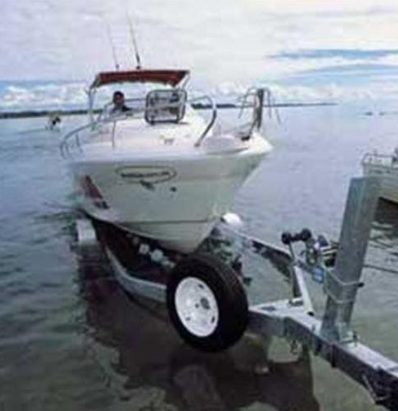So, you finally decided to venture into the world of boating, huh? Well, before you set sail and let the wind guide you, there’s one crucial thing you need to know – how to properly trailer and launch your boat. Whether you’re a seasoned boater or a newbie, understanding the proper procedure is essential for a smooth and successful boating experience. From securing your boat on the trailer to safely launching it into the water, this article will walk you through the step-by-step process, ensuring you’re ready to hit the open seas with confidence.
Before Trailering
Before you hit the road with your boat, there are a few things you need to do to ensure a smooth and safe journey. First and foremost, inspect both your boat and trailer thoroughly. Check for any signs of damage, such as dents, cracks, or loose parts. It’s important to address these issues before heading out to avoid any further damage or accidents on the road.
Next, make sure you have all the appropriate equipment and documentation. This includes having a valid driver’s license, boat registration, and any necessary permits or stickers. Additionally, ensure that your trailer is equipped with a functioning brake system, proper lighting and reflectors, as well as safety chains and tie-down straps.
Lastly, prepare your boat and trailer for transport. This includes removing any loose items and securing everything properly. Close all compartments and hatches, and make sure any removable parts, such as navigation equipment or fishing gear, are safely stored away. Double-check that the boat is securely attached to the trailer and that the trailer is properly hooked up to your vehicle.
Proper Hookup
Securing a level surface is crucial before attempting to hook up your trailer. Find a flat and stable area where you can safely connect your boat and trailer to your vehicle. This will ensure that the trailer remains level while driving, promoting better stability and control.
Once you’ve found a suitable surface, align your vehicle and trailer. Back your vehicle up slowly, making sure the trailer coupler and the hitch ball on your vehicle are perfectly aligned. Take your time with this step to avoid any potential damage or misalignment.
With the proper alignment, connect the coupler and safety chains. The coupler should easily slide over the hitch ball, with the locking mechanism engaged to secure them together. Attach the safety chains on both sides of the trailer to the vehicle’s hitch, crossing them underneath for added security. Ensure they are properly tightened and not dragging on the ground.
Next, attach the wiring and lights. Connect the wiring harness from the trailer to your vehicle, ensuring all the lights are functioning correctly. Check the turn signals, brake lights, and taillights to ensure they are all working before hitting the road. This is not only essential for your safety but also to comply with road regulations.
Before you hit the road, always double-check the hitch connection. Give it a firm tug to make sure it’s securely attached and properly locked. This will give you peace of mind knowing that your boat and trailer will remain securely connected throughout the journey.
Loading and Securing the Boat
Properly positioning the boat on the trailer is an important step to ensure stability and balance while traveling. The boat should be centered on the trailer, with equal weight distribution on both sides. Make sure the boat is sitting level and consider using leveling blocks or wedges if necessary.
Once the boat is positioned properly, attach the bow strap or winch hook. This will secure the front of the boat to the trailer, preventing it from sliding or shifting during transport. Ensure the strap or winch hook is tight and in good condition, as it will bear the weight of the boat during the journey.
To enhance the stability of the boat, secure the stern tie-downs. These straps should be attached to the rear of the boat and tightly fastened to the trailer. They prevent any movement or rocking of the boat while in transit, providing an added layer of security.
Before you hit the road, always double-check the trailer hitch. Inspect the connections between the trailer and the boat to ensure they are secure. Give the boat a gentle push and make sure it doesn’t budge. This final check is crucial to guarantee that your boat is properly loaded and secured for the journey ahead.
Pre-Launch Checklist
Preparing for a boat launch requires careful consideration of various factors. Start by choosing the right boat ramp. Ensure that the ramp is suitable for your boat’s size and weight. Check local regulations and any additional requirements, such as permits or fees, to avoid any surprises or legal issues.
Before launching, it’s important to prepare the boat itself. This includes removing any coverings, such as tarps or boat wraps, and ensuring all compartments and hatches are open and accessible. Check the fuel levels, engine oil, and any other fluids to ensure everything is in proper working order.
Securing all loose items onboard is crucial to prevent accidents or damage. Make sure everything is properly stowed away, including gear, equipment, and personal belongings. Remove any lose or fragile items that could potentially shift or break during the launch or while in the water.
Lastly, remove any obstructions from the trailer or boat. This includes removing the bow strap or winch hook and loosening or removing the stern tie-downs. Ensure that the boat is free from any ties or restraints that could impede a safe and successful launch.
Launching Procedure
Backing your trailer into the water is an important step in the launching process. Take it slow and steady, ensuring that the trailer remains aligned with the boat ramp. Use your mirrors and ask for assistance if needed to ensure accuracy and prevent any damage to the trailer, boat, or other vehicles at the ramp.
Once the trailer is positioned in the water, release the bow strap or winch hook. This will allow the boat to float freely off the trailer. Keep a firm grip on the boat and guide it away from the trailer as it gently slides off. Be mindful of the boat’s movement and avoid any sudden jerks or aggressive maneuvers.
Release the stern tie-downs to completely separate the boat from the trailer. These straps should be detached carefully and stored away to avoid any tangling or dragging while in the water. Ensure that the boat is completely disconnected from the trailer before attempting to drive away.
Gently reverse the boat away from the trailer and into the water. Take your time to familiarize yourself with the boat’s controls and handling in the water. Allow the boat to float freely for a moment, ensuring that there are no immediate issues or problems before proceeding further.
With the boat launched, park your vehicle in the designated area. Keep in mind any specific parking regulations or guidelines at the ramp. Ensure that the vehicle is parked securely to avoid any accidents or damage and make sure the trailer is not obstructing the ramp or other boats.
Post-Launch Checklist
After a successful boat launch, there are a few post-launch tasks that need to be addressed. Start by retrieving the trailer from the water. Back it down the ramp carefully, aligning it with the boat to facilitate an easy retrieval process. Once the trailer is under the boat, slowly and carefully pull it out of the water.
Secure the boat on the trailer before hitting the road. Attach the bow strap or winch hook, ensuring that it is tight and properly secured. Check the stern tie-downs as well, making sure they are tight and properly fastened. These steps are crucial to prevent any shifting or damage to the boat during transport.
Drain any excess water from the bilge and engine compartments. This will prevent any potential damage caused by water sitting in these areas during transportation. Ensure all drain plugs are properly tightened, and the boat is free from excessive water before hitting the road.
Before you head off, check the trailer lights and connections. Make sure all the lights are functioning properly, including the turn signals, brake lights, and taillights. Test them again before departing to ensure they are working consistently. This will ensure that you are visible on the road, promoting safe driving conditions.
Lastly, ensure that all gear is safely stowed. Double-check that everything is properly secured, whether it’s fishing equipment, coolers, or any other items you may have brought with you. This will prevent any accidents or damage caused by objects shifting or falling during transit.
Safety Guidelines
When trailering and launching a boat, it’s essential to prioritize safety. Observe weight limits and load distribution on your trailer to prevent any excessive strain or imbalance. Overloaded trailers can become unstable and difficult to control, increasing the risk of accidents.
Maintaining proper tire pressure is crucial for safe trailering. Underinflated tires can lead to poor handling and reduced stability, while overinflated tires can result in uneven wear and decreased traction. Regularly check the tire pressure and adjust it as needed to ensure optimal performance.
Ensure that your trailer brakes are functioning properly. Test them before each trip and address any issues promptly. Faulty brakes can compromise your ability to control the trailer, especially when driving downhill or making sudden stops.
Always use appropriate safety equipment while trailering and boating. This includes wearing life jackets or personal flotation devices for everyone on board the boat. Additionally, carry essential safety items such as a first aid kit, fire extinguisher, and signaling devices in case of emergencies.
Be aware of weather and water conditions before launching your boat. Check the weather forecast and be prepared for any changes or adverse conditions. Avoid boating in stormy or rough waters that can endanger your safety and the integrity of your boat.
Legal and Documentation
To ensure legality and compliance with regulations, obtain proper boat registration. Register your boat with the appropriate authorities and display the registration numbers and sticker as required. This helps law enforcement easily identify your boat and ensures you are adhering to local boating laws.
Carry the required safety equipment on your boat at all times. This includes personal flotation devices for every passenger, fire extinguishers, visual distress signals, and sound-producing devices. Familiarize yourself with the specific safety equipment required in your region to avoid any penalties or citations.
Always follow local boating laws and regulations. Different regions may have specific rules regarding boat speed limits, navigation, and equipment requirements. Stay informed and adhere to these regulations to ensure a safe and enjoyable boating experience.
Maintenance and Check-ups
Regularly inspect your boat and trailer to identify any signs of damage or wear. Check for signs of rust, corrosion, or degradation in both the boat itself and the trailer. Address any issues promptly to prevent further damage and ensure the longevity of your boat and trailer.
Pay special attention to the trailer wheel bearings. These should be regularly serviced to maintain proper performance and reduce the risk of breakdowns. Grease the wheel bearings as recommended by the manufacturer and inspect them for any signs of wear or damage.
Keep your boat clean and well-maintained. Regularly wash the boat to remove any dirt, salt, or contaminants that can cause damage over time. Check the boat’s exterior and interior for any signs of wear, such as loose fittings or cracks, and address them promptly to prevent further deterioration.
Troubleshooting Tips
It’s not uncommon to encounter some issues while trailering and launching a boat. Here are a few common problems and their solutions:
If you experience trailer sway while driving, reduce your speed and avoid any sudden steering movements. Ensure that the load on the trailer is properly balanced, with the majority of the weight centered over the axles. Consider investing in a weight distribution hitch or sway control system for added stability.
Having trouble with launching and retrieving? Ensure that the boat is properly aligned with the trailer before attempting to load or retrieve it. Take your time and be patient, making any necessary adjustments to ensure a smooth and successful process. If needed, ask for assistance from someone experienced in boat handling.
By following these proper trailering and launching procedures, you can have a safe and enjoyable boating experience. Remember to prioritize safety, comply with regulations, and regularly maintain your boat and trailer. With careful preparation and attention to detail, you’ll be on your way to many fantastic boating adventures.





